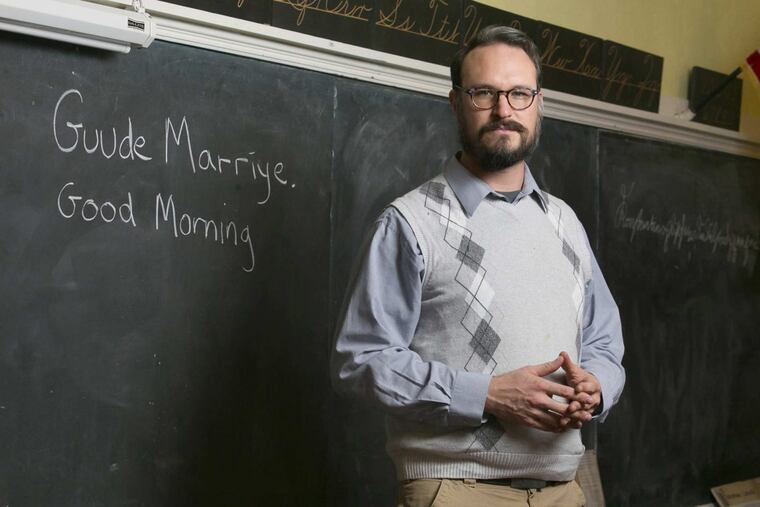Keeping the Pennsylvania Dutch language alive - and thriving
There's approximately 400,000 people who speak Pennsylvania Dutch in the United States and Canada, spreading west and north with the Amish.

On any Amish homestead, after labor's last push and a check for 10 fingers and 10 toes, family members have heard one of two things for centuries.
"Sis en Bu" or "Sis en Maedel."
"It's a boy" or "It's a girl."
That language is Pennsylvania Dutch, and the gender announcement isn't some old-fashioned tradition the Amish use only during childbirth. They "talk Dutch" about horse manure and carrots, about the weather, and whether a buggy's wheel needs mending before a trip to the market.
"It's common for our people to pass it along to the next generation,´ said Moses Smucker, an Amishman who runs Smuckers Quality Meats at the Reading Terminal Market. "We spoke it to them as soon as they were born."
The notion that Pennsylvania Dutch could go fallow is absurd to the Amish, who have been doubling their population every few decades.
"It's actually considered the fastest-growing small-minority language in the United States," said Patrick Donmoyer, director of Kutztown University's Pennsylvania German Cultural Heritage Center in Berks County.
But outside "plain" communities in the state and beyond, Pennsylvania Dutch is becoming rarer.
Donmoyer, whose family moved to Lebanon County from Philadelphia in 1732, said that approximately 400,000 people speak Pennsylvania Dutch in the United States (principally in Pennsylvania, Ohio and Indiana) and Canada. Its influence is deepest in about 14 counties in the southeastern and central parts of Pennsylvania, with thousands of residents apart from Amish and several Mennonite communities.
"They are hardworking, proud and stubborn people with an agricultural background," said Doug Madenford, of nonsectarian Pennsylvania Dutch. The Reading native grew up hearing the language on a family farm. "We don't like change and we like to hold onto our values. The Pennsylvania Dutch are unique, with their own culture and foods and art. We've fought in all of the wars and were some of the first people who called for the abolition of slavery."
Among the Amish, the average age of a speaker of Pennsylvania Dutch is 17, Donmoyer said. For nonsectarian speakers, the average age is 75 — a number that he and other enthusiasts are trying to lower.
"I speak only Pennsylvania Dutch to my kids," said Madenford, who teaches German in the Keystone Central School District near State College ."My daughter is 5 and my son is 3 next week. In my generation, people in their 30s and 40s, it's hard to find somebody who can speak it."
Madenford, like Donmoyer, picked up the language from a grandparent. Together they edit Hiww wie Driwwe ("Over here, like over there"), a Pennsylvania Dutch newspaper and website. Madenford also has a YouTube channel dedicated to the language, with comedy bits thrown in, and is writing a children's book.
"My goal is to make sure it doesn't completely die out," Madenford said. "I get so many e-mails from people who are younger and they want to reconnect. They feel they missed out on something."
The Pennsylvania Dutch language — this can get confusing — is German, not Netherlands Dutch. It was spoken in the Rhine Valley and southwestern Palatinate region of what today is Germany.
"The average Pennsylvania Dutchman, if you dropped them in the Netherlands, would be lost," Madenford said.
In Germany, Pennsylvania Dutch speakers could get by in most of the country the same way someone from Vermont could function in Dublin or the Louisiana bayou.
In America, there was an academic movement to drop the word Dutch and call the language Pennsylvania German, but one of the distinct traits of the region — stubbornness — won out.
"There was no country called Germany, and there was no national identity called German at the time these people were coming here," Donmoyer said. "Culturally, there was an identity but it was very regional, not a national idea like there is today. One would be a Palatine, or a Swabian, or an Alsatian, or Swiss, etc."
There's a popular opinion that the word "Dutch" is a corruption of "Deutsch," the word for the German language. When settlers were coming to Pennsylvania in the 18th century, Donmoyer said, the word "Dutch" was Old English for speakers of High and Low German, not a specific country.
"Folks often feel the need to have some sort of an ax to grind about the word 'Dutch,'" Donmoyer said. "As though a group of people would be so backward that they didn't know what they were called."
Two world wars fought against Germany and the 20th century drive toward assimilation made Pennsylvania Dutch speakers outside Amish and Old Order Mennonite communities resort more to English, Madenford said.
"It wasn't in fashion to be speaking German in those times," he said. "There was a real push and feeling that we really need to be more and more American in that post-World War II era, and the parents of baby boomers decided it wasn't something we were going to teach our kids."
Both Madenford and Donmoyer believe the state could do a better job of promoting this slice of Pennsylvania life, perhaps do some advertising in the southwestern portion of Germany to draw tourists.
What Donmoyer finds most interesting about the language and culture is how it relates to today and immigrants' struggles to retain language and culture while becoming American.
"Here is a culture that managed to hold to its language, not because we were being stubborn and saying we're going to hold on to a European identity," he said. "They kept it because keeping your culture was a way of being American. They were emphasizing their American-ness by saying, 'We have the right to be who we are.'"